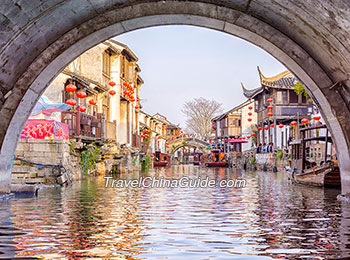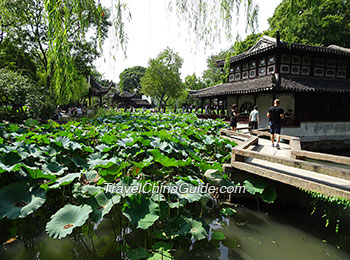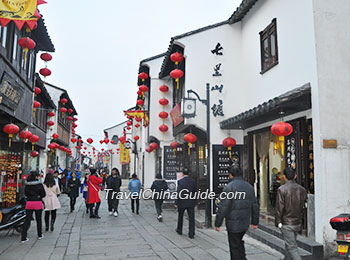Suzhou Old Town has been the cultural center of Jiangnan – the regions south of the
Yangtze River for long. It is in a typical chessboard layout, with rivers and streets parallel to each other. It has many classic gardens and the longest river channel in China’s water towns, more than 30 old streets and alleys, 70 ancient bridges, 22 ancient revetments, 639 old wells and 22 ancient memorial archways. Here, you can not only explore the cultural heritages for thousands of years, but also feel the elegant and peaceful charm of the past times. Three highlights of Suzhou Old Town - gardens, ancient streets and city wall are the unmissable attractions.
History of Suzhou Old Town since 2,500 Years Ago
 |
| Suzhou Old Town |
Suzhou was built in 514BC under the order of the King of Wu. In the Qin and Han Dynasties (221BC - 220AD), the scale of Suzhou City has been expanded and a large number of private gardens have begun to be built. The construction of the Grand Canal during the Sui Dynasty (581 - 618 AD) made Suzhou the mainstay of the water and land transportation. During the Tang Dynasty (618-907), Suzhou became the second largest city in China after the capital Chang ’an. The double chessboard pattern - streets parallel to rivers has basically been shaped. During the Song Dynasty (960-1279), the temples and architecture stood tall and they formed a rich urban facade with the river. There were more and more gardens during the Qing Dynasty (1644-1912), and Suzhou boasted “Garden Pavilions in Half Town”. When the Opium War broke out in 1840, the opening of the trading port caused many western-style buildings to be built. After the founding of PRC, Suzhou was re-planned, retaining the original chessboard pattern, increasing the gardens, and expanding outward.
 Read More: Suzhou History
Read More: Suzhou History
Chessboard Layout
Suzhou Old Town now covers an area of 14.2 square kilometers (near 3,509 acres), basically maintaining the double chessboard pattern. From a bird’s eye view, there are three vertical, three horizontal and one ring rivers and the streets are parallel to the rivers. Above the rivers, stand many bridges. Along the streets, are grey-tiled residences with white walls, many of which are famous historical gardens. The old town now has a total of 35.28 kilometers (21.9 miles) rivers and 168 bridges, making it China’s water town with the longest river channel and the most bridges and bringing it the reputation of “Oriental Venice” by Marco Polo.
Three Highlights of Suzhou Old Town
The classical gardens of Suzhou live up to the reputation of “Jiangnan gardens are the best in the world, and Suzhou gardens are the best in Jiangnan”. These gardens not only have beautiful scenery but also convey many traditional Chinese thoughts and cultural connotations. The gardens in Suzhou Old Town have quite long history and are preserved intact.
Humble Administrator’s Garden in
Ming Dynasty (1368-1644) is the largest and most renowned one in Suzhou; with typical Qing style,
Lingering Garden is well-known for its magnificent halls and colorful buildings;
Canglang Pavilion built in Song Dynasty (960-1279) and
Lion Grove Garden in
Yuan Dynasty (1271-1368) are also the must-see gardens in Suzhou Old Town.
 | | Humble Administrator's Garden | |  | | Shantang Street | |
These ancient streets and alleys in Suzhou Old Town are either gentle and quiet, or bustling and lively, which are their unique temperament that attracts so many tourists. Some of the ancient streets renovated by later generations still retain the charm of the old street. The strong living atmosphere, peaceful water and stone brick pavement constitute a tranquil scene with strong ancient flavor. However, lively atmosphere of some street at night brings tourists another unique feeling about the thousand-year streets. Numerous shops rich in goods have become another scene of the old streets. Tourist can visit Suzhou traditional handicraft – loom, cheongsam and cork patchwork, enjoy melodious Suzhou Pingtan opera - storytelling and ballad singing in Suzhou dialect and taste delicious local snacks.
Pingjiang Road and
Shantang Street are the two most famous old streets full of elegant and lively atmosphere and also good places to sample local food.
There are eight city gates in Suzhou Old Town, the oldest of which can date back to the Spring and Autumn Period (722-481 BC). The Suzhou City Wall not only formed a unique landscape by the city moat, but also witnessed 2,500 years of change of Suzhou city. Among these city gates, Xiangmen City Gate is the must-see attraction. There is a hidden museum in the southern section of this city wall - the Suzhou City Wall Museum where you can better understand the historical changes and archaeological results of the ancient city wall through pictures, models and real exhibits –ancient rammed earth city wall specimens superimposed on ash pit during the warring states period and water gate mortar in Han Dynasty (202BC-220AD)… In addition, cycling along the foot of the ancient city wall is also a very good choice to experience the quiet and long history of the Suzhou Old Town.
More Attractions in Suzhou Old Town
How to Get to Suzhou Old Town

Xiangmen City Gate: Take
metro line 1 to Xiangmen City Gate Station; or take bus line 32, 112, 178, 200, 202, 307 or 900 and get off at Xiangmen City Gate Station.

Pingjiang Road: Take metro line 1 to Lindun Road Station or Xiangmen Station, then walk for about 300m (330yd) to the south end of the road; or take bus line 310, 305 and 9009 to Pingjiang Road Station.

Shantang Street: Take
metro line 2 to Shantang Street Station; or take bus line 7, 34, 44, 64, 85, 304, 315, 317, 415, 522, 921 or 980 and get off at Shantang Street Station.
- Last updated on Apr. 21, 2020 -

![]() Read More: Suzhou History
Read More: Suzhou History
